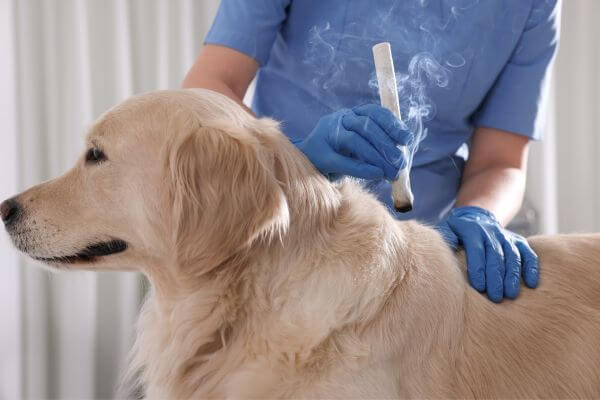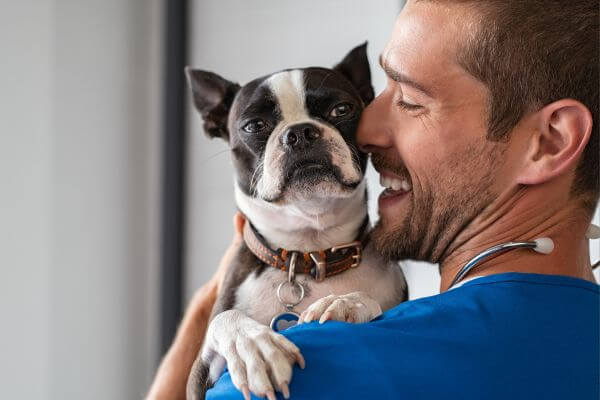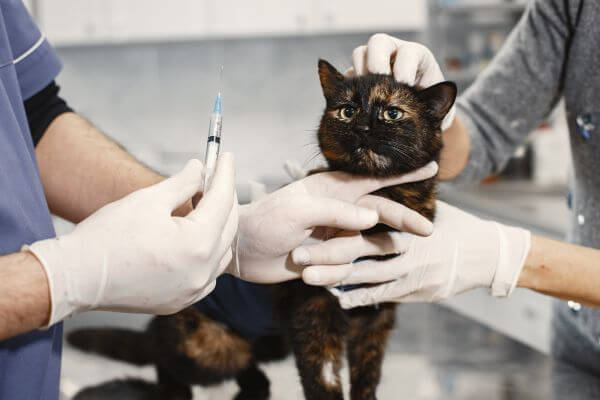Discover the latest innovations in pet health. Pet health is a constant concern for owners, and finding effective alternative treatments is essential to ensure the well-being of our beloved pets.
Holistic Approach in Veterinary Medicine

Modern veterinary alternative treatments medicine has increasingly embraced holistic approaches to treat and care for pets. This trend reflects the search for more natural and less invasive treatments that consider the physical, mental, and emotional well-being of pets.
In recent years, there has been a significant increase in demand for alternative therapies such as acupuncture, chiropractic, and herbal medicine to complement traditional veterinary care. These approaches offer a range of benefits, from pain relief to improving quality of life and promoting overall health.
Acupuncture, for example, has been shown to be effective in treating chronic pain, arthritis, skin problems, and even behavioral issues in dogs. This ancient Chinese practice uses fine needles to stimulate specific points on the body, promoting energetic balance and stimulating the body’s natural healing ability.
Veterinary chiropractic focuses on correcting musculoskeletal problems, helping to relieve pain and improve mobility. By adjusting the spine and joints, veterinary chiropractors can address dysfunctions that affect the nervous system and overall health.
Herbal medicine, on the other hand, uses medicinal plants to treat a variety of conditions in pets, offering a safe and natural alternative to conventional medications. Herbs such as chamomile, valerian, and calendula can be used to relieve anxiety, promote healthy digestion, and strengthen the immune system.
Benefits of Positive Reinforcement in Dog Training
Positive reinforcement is a widely recognized and used technique in dog training. Instead of punishing undesirable behaviors, positive reinforcement rewards desired behaviors, promoting a relationship of trust and respect between the owner and the dog.
By using positive reinforcement, owners can effectively teach basic commands, correct problematic behaviors, and even train fun tricks in a humane and effective manner. This approach encourages dogs to think and learn on their own, making the training process more stimulating and rewarding for both.
Furthermore, positive reinforcement strengthens the bond between the owner and the dog, promoting clear communication and a relationship based on mutual respect. Dogs are naturally motivated by the desire to please their owners and receive rewards, making positive reinforcement a powerful tool for shaping desired behaviors and strengthening the emotional connection.
Instead of using punitive methods that can cause stress and anxiety in dogs, positive reinforcement creates a positive and encouraging learning environment. By rewarding desired behaviors, owners can cultivate a healthy and harmonious relationship with their dogs, based on trust and cooperation.
Natural Feeding for Dogs: A Healthy Alternative
Natural feeding for dogs has gained increasing popularity as it offers a healthy and balanced alternative to processed commercial foods. This approach values fresh and natural ingredients, providing a diet closer to what dogs would consume in the wild.
By opting for natural feeding, owners have full control over the ingredients their dogs consume, ensuring the quality and freshness of the food. This allows for tailoring the diet according to the individual needs of each dog, taking into account factors such as age, size, activity level, and health conditions.
Additionally, natural feeding can help prevent a variety of common health problems in dogs, such as food allergies, obesity, digestive issues, and chronic diseases. By eliminating dyes, preservatives, and low-quality ingredients, owners can reduce the risk of health problems related to nutrition.
Natural feeding also promotes better oral health, as fresh and raw foods help strengthen teeth and gums, preventing tartar buildup and the development of periodontal diseases. Furthermore, dogs fed a natural diet tend to have shinier coats, healthier skin, and more balanced energy levels.
Alternative Therapies: Promoting Pet Well-being

Alternative therapies complement conventional medicine by targeting the physical and emotional well-being of pets, treating the animal as a whole and considering the underlying causes of health problems.
Aromatherapy uses natural essential oils to relax, relieve stress, and treat physical and emotional conditions in dogs and cats. Music therapy uses specific music to reduce anxiety, improve mood and stimulate healing in animals, with studies showing its benefits on animals’ mental and emotional health.
Crystal therapy balances chakras and promotes physical and spiritual healing with energy stones. This ancient practice is increasingly adopted by owners concerned about the holistic well-being of their animals, offering a natural, non-invasive approach to promoting health and balance.
Therapeutic Massage: Relaxation and Well-being for Dogs
Massage therapy offers physical and emotional benefits for dogs. Relieves pain, reduces stress, improves circulation and promotes recovery after injuries or surgeries.
During a session, the therapist uses gentle movements to manipulate muscles and tissues, releasing tension and promoting relaxation. This stimulates the lymphatic system and eliminates toxins.
In addition to the physical benefits, massage reduces anxiety, improves mood and strengthens the bond between dog and owner. Many dogs enjoy touch, offering a unique connection and relaxation.
It is especially beneficial for elderly dogs or dogs with mobility problems, relieving stiffness, promoting flexibility and improving quality of life. It is also useful for athletic dogs, preventing injuries and speeding recovery after intense activities.
Canine Reflexology: Energy Balance and Well-being

Canine reflexology is a therapeutic technique that stimulates specific points on dogs’ feet and paws, connected to organs and systems in the body. This gentle practice relieves chronic pain, digestive problems, sleep disorders and anxiety.
During a session, the therapist applies light pressure to points on the dog’s paws, adjusting as necessary. Many dogs relax deeply, enjoying the benefits of massage therapy.
Canine reflexology is useful for elderly dogs or dogs with chronic illnesses, improving blood circulation, strengthening the immune system and promoting relaxation in anxious or stressed dogs.
Yoga for Dogs: Promoting Balance and Flexibility
Dog yoga, also known as “doga,” combines stretching, breathing and relaxation to balance dogs physically and emotionally. This practice improves flexibility, strengthens muscles and reduces stress in dogs of all ages.
During the sessions, owners and dogs perform adapted postures, relieving muscle tension and promoting body awareness.
In addition to physical benefits, doga can also have a positive impact on.
Dog yoga reduces anxiety, improves mood and strengthens the bond between owner and dog. It’s a unique chance for connection and mutual relaxation, great for elderly dogs or those with mobility problems.
It maintains joint flexibility, strengthens muscles and promotes balance, and is also fun physical exercise and mental stimulation for dogs of all ages.
Reiki for Animals: Energy for Well-being

Reiki is a therapeutic technique that balances the physical, emotional and spiritual. Efficient in relieving stress in pets, it is gentle and non-invasive.
During a session, the therapist transmits energy to the animal’s body, focusing on unbalanced areas. This restorative energy encourages self-healing and is helpful in stressful situations.
Reiki benefits the physical and emotional health of animals, reducing anxiety and restless behavior. Treats the animal as a whole, addressing underlying causes of health problems.
Aromatherapy for Dogs: Well-being through Natural Scents
Aromatherapy for dogs is a therapeutic practice that uses natural essential oils to promote physical and emotional balance in animals. This gentle and non-invasive technique can help relieve stress, reduce anxiety, alleviate pain, and promote overall well-being in dogs.
During an aromatherapy session, owners can use essential oils diluted in water or carrier oil and apply them to the environment or directly to the dog’s skin. The natural aromas are inhaled by the animal, stimulating the olfactory system and positively affecting the nervous and emotional systems.
Some popular essential oils in aromatherapy for dogs include lavender, chamomile, peppermint, and lemongrass. Each oil has unique therapeutic properties that can help relieve different symptoms and promote physical and emotional balance. However, it’s important to use essential oils with caution and always dilute them properly to avoid adverse reactions.
Aromatherapy for dogs can be especially helpful in stressful situations, such as travel, visits to the veterinarian, or social events. The calming and comforting aromas of essential oils can help soothe the dog, reduce anxiety, and promote a state of relaxation and well-being.
Herbal Medicine for Dogs: Benefits of Medicinal Plants
Phytotherapy for dogs uses medicinal plants to naturally treat various health conditions, aiming to alleviate symptoms, promote healing and improve the animals’ overall well-being.
Plants like chamomile, with calming and anti-inflammatory properties, are useful for skin problems, anxiety and gastrointestinal disorders. Other plants, such as calendula and valerian, are also used for their healing and calming properties.
It is crucial to consult a veterinarian or specialist before starting any herbal treatment, ensuring the safety and effectiveness of the care.
Promoting Holistic Well-being for Dogs
In this article, we discuss alternative therapies and complementary medicine for dogs, such as positive reinforcement in training, herbal medicine, and Reiki. These practices aim to balance dogs physically, emotionally and spiritually, improving their quality of life.
It is essential to consult a professional before starting any treatment, as each dog is unique. Options such as aromatherapy, massage therapy and yoga can be incorporatedto promote your dog’s well-being.
Explore these options to ensure your dog lives a full life of joy and love.